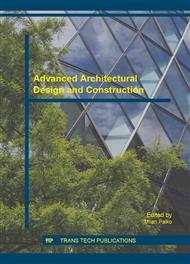p.96
p.105
p.115
p.121
p.127
p.133
p.139
p.146
p.152
BIM and Prediction of Thermal Stability in Underroof Spaces
Abstract:
Current increasing of costs for the acquisition of buildings causes effort to efficiently use all the space in these construction projects. The aim is therefore to make maximum use of under-roof space, both in new buildings and in buildings already standing. Because of the trend of construction with light wooden structures wrapped in thermal isolation, it is not easy to avoid summer overheating in under-roof spaces. For this reason, we’ve focused on optimizing building structures in terms of overheating in summer, so that additional costs for air conditioning were negligible or, ideally, non-existent. It is well known from our previous experience that there is smaller rise and fluctuation of indoor air temperature in rooms with heavy mass constructions (e.g. reinforced concrete, bricks, etc.) compared to rooms with light structures.
Info:
Periodical:
Pages:
127-132
Citation:
Online since:
January 2016
Authors:
Price:
Сopyright:
© 2016 Trans Tech Publications Ltd. All Rights Reserved
Share:
Citation:


